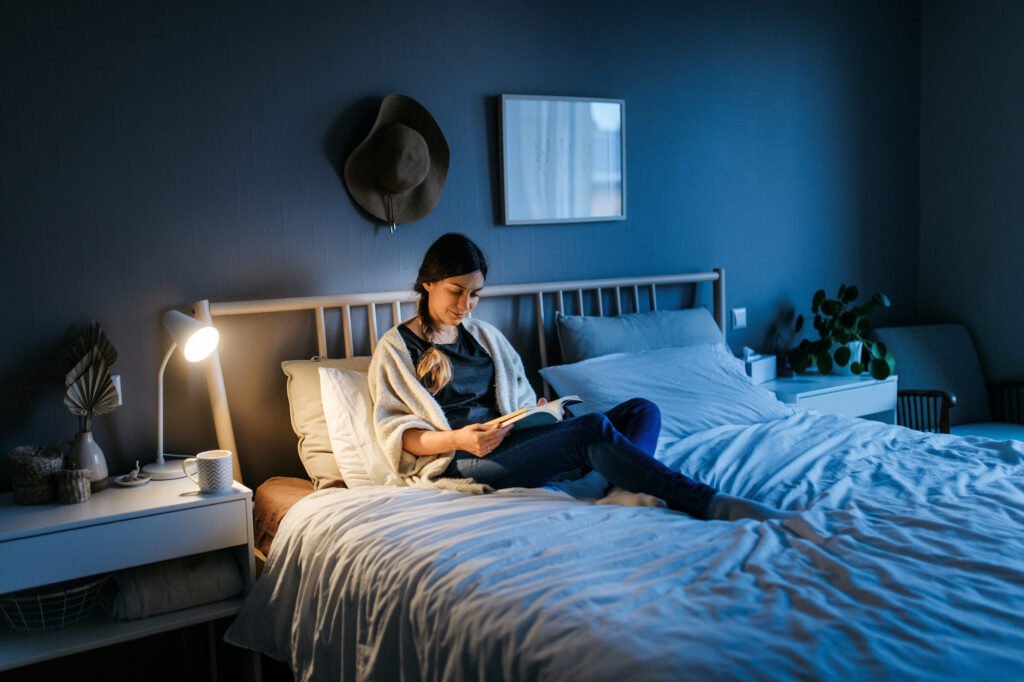
Blue light is known for interfering with sleep. Namely, it interrupts your body from making optimal levels of melatonin, which is the hormone that makes you sleepy and helps you stay asleep. A new innovation could remove some of that light from our devices, so being on them closer to sleep may not be as disruptive to our circadian clocks — and our ability to get a good night of rest.
Blue light is beneficial during the day, helping bolster attention, reaction times, and even mood. It comes from phones, TVs, lamps, and other electronics that people use. But when you’re exposed to blue light at night, it doesn’t exactly set you up for your best night of sleep.
That’s why researchers from Korea came up with a more “human-centric” LED light that they say has the potential to make us drowsy or alert on command (1).
Blue light is emitted in wavelengths from 380 to 500 nanometers, but those wavelengths aren’t all the same. They have different effects on our health. Wavelengths that halt melatonin from being produced are about 460 to 500 nanometers. Translation: Creating a light source below that could theoretically not be as harmful for circadian health.
Changwook Kim, PhD, a researcher in the electrical engineering school at Kookmin University in Seoul, along with his team wanted to make a light source that supports circadian rhythms regardless what time of day it is used. The team made two LEDs that gave off different wavelengths of blue light; one was made for daytime use at 475 nanometers and the other was for evening use and gave off about 450 nanometers — just outside that range known to interrupt sleep.
“In this respect, daytime human-centric lighting enhanced with light at a wavelength of 480 nanometers can suppress melatonin more rapidly,” Kim told Sleepopolis. “Nighttime human-centric lighting contains very little light in the 480-nanometer range, which allows them to maintain higher levels of nocturnal melatonin compared to conventional lighting.”
The difference between other similar concepts (Kim says some are already on the market) and his is that the others combine multiple LED components of different wavelengths to create the required wavelength.
“The lighting used in this study is different in that it is designed to control melatonin secretion using a single LED package,” Kim says.
Building Better Light for Sleep
The researchers built the two LEDs into bulbs that emitted white light. They put the new LED bulbs alongside conventional LED bulbs in ceiling fixtures in a room without windows. The room contained a bed, desk, and treadmill. To test it out, they had 22 volunteers stay in the room for three days.
During their stay, a computer controlled which type of LED was on or off. Then they took saliva samples from the participants. Results showed that the modified human-centric LED lights boosted participants’ melatonin levels by 12.2 percent and lowered melatonin produced in the day by 21.9 percent compared to traditional LED lights.
Their findings were published on Nov. 21st in the journal ACS Omega.
Lights That Foster Melatonin Production
How exactly does light stop melatonin production? Melanopsin cells in photoreceptor cells (ipRGCs) in the retina absorb light with a wavelength of 470 to 490 nanometers, which stops melatonin secretion, Kim says.
Kim’s not a health professional, but he says the method of controlling circadian rhythm has almost no negative effects compared to other methods like taking sleeping medicine.
“Even if devices are modified to reduce the effects of blue light on alertness and sleep, there are other mechanisms through which screen-based activities interfere with sleep health,” notes Lauren Hale, PhD, a professor at Stony Brook University who studies sleep health. Devices can be disruptive for sleep in other ways, such as notifications and ringtones.
“The content from screens can be psychologically stimulating and affect sleep onset and sleep quality,” Hale tells Sleepopolis.
In other words, even if the light doesn’t stop your body from making melatonin, devices can still be a no-no if you’re going for good sleep hygiene.
Bringing Sleep-Friendly LEDs On the Market
The researchers would like to see LED light manufacturers consider these findings when producing electronics.
Kim says similar projects to modify lighting have been attempted, and there are a few products on the market.
“It is already being applied to various applications such as lighting fixtures, light bulbs, and stands using human centric lighting LED light sources such as Samsung Electronics,” Kim says.
Prices for items with the modified bulbs would go up because long-wavelength chips are used instead of 450-nanometer chips, which are the main part of existing LEDs, Kim adds.
But for some of us that like binge-watching in bed, or want a late-night scroll, the technology could mean that our habits wouldn’t totally ruin a night of sleep.
Sources
Kim, Changwook. Author interview. December 2024.
1. American Chemical Society, “This next generation blue light could potentially promote or hinder sleep on command,” https://www.sciencedaily.com/releases/2023/12/231214132513.htm; December 14, 2024.



























